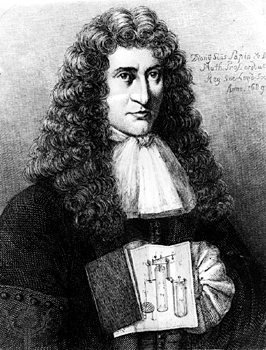Denis Papin
- Birthplace
- Blois, France
- Death date
- 1712/01
- Associated organizations
- The Royal Society
- Fields of study
- Physics, Mechanical Engineering
Biography
Denis Papin was a French-born British physicist who invented the pressure cooker, and inspired the production of the first cylinder and piston steam engine by suggesting its construction. Though the design of the first pressure cooker was not practical, it was eventually improved by future engineers. Papin's invention served as a basis for the development of the steam engine, and other steam powered devices. [1]
Denis Papin was the son to Denis Papin Sir and Madeleine Peneau, whose family had a tradition of being medical practitioners. They had thirteen children, the forth being Denis who was named after his father. His date of birth is unknown, however the date of his baptism was August 22, 1647. He was presented for baptism by his uncle, Issac Papin, within his firm Huguenot religion.
At the age of six, he was put into his uncle Nicolas Papin's care, a medical doctor in Saumu. In Saumur, Denis attended the the Huguenot Academy for his early education, where later in 1661 he moved on to study medicine at the University of Angers. He graduated with a medical degree on the 4th of June in 1669, but after graduating had a low opinion for both the teaching and fellow students.[2]
After receiving his M.D. in 1669, he originally intended to practice medicine. However, he found the practices of medicine to be boring, and instead found interest within mathematics and mechanics. Thus, he traveled to Paris to work as an assistant to Christiaan Huygens in developing mechanical devices. Papin's served as a skillful mechanic for Huygens and helped in constructing an air pump, and performed a number of experiments. He published papers in 1674 under Experiences, in which he described the various tests he performed, including attempts to preserve food within the vacuum. [3]
Shortly after publication, Papin had left Paris to travel to London where he was well received by Robert Boyle, who had read his papers on the development of the air pump. Papin went on to assist Boyle in his laboratory and with written pieces. Around this time he also introduced improvements to the air-pump by making it with double barrels, and replacing the two valves the turn-cock hitherto used. Subsequently he invented the condensing-pump, and in 1680 he was nominated by Robert Boyle into the Royal Society. Additionally, in the previous year, he had exhibited to the society his famed "steam digester, engine for softening bones." It is more commonly known today as the pressure cooker. [4]
Also known as the Papin Digester, the cooker was made from cast metals (most likely iron) with a lid that locked in place with a screw-like clamping mechanism. As the food heated in the liquid, the trapped steam raised to cook the food at a temperature 15% higher then the boiling point of water. The super heated steam cooked the food at a much faster rate than ordinary methods available at the time. As this was a new method, the lack of understanding about regulating the steam pressure and the inability to accurately regulate the cooking temperature caused many of the early devices to explode. Another major issue was that the materials used to make the pressure cookers would often crack, letting steam leak out. Though the device suffered from severe mechanical issues that rendered it unfit for commercial purposes, it served as the basis for future steam engines. [5]
In 1690 he published his first work on the steam engine in his De novis quibusdam machinis. The purpose was to raise water to a canal between Kassel and Karlshaven by using the differences in heated pressures. In 1705, he began to work with the physicist and philosopher Gottfried Wilhelm Leibniz to sketch some early designs of a steam engine. These designs would later inspire the development of a working model. After completing the sketches, he went on to work on various other prototype inventions, including the submarine, air gun, and grenade launcher. In 1707 he had also built and used a paddle boat. In the same year, after running into financial troubles, he returned to the Royal Society in hopes of begin employed. At the, time Issac Newton was the president, and seemed to give no encouragement to employ Papin, as the society was suffering from financial issues and was in no position to hire additional staff. Papin continued to write papers and publish them, including improvements for blast furnaces.
Around the beginning of 1712, Papin had died in obscurity and poverty. The last known letter he wrote was dated the 23rd of January in response to a 10 pound thank you donation given to him by the Royal Society. It is likely that with no relatives or money known to those who found him dead, he was buried within an unmarked grave. It wasn't until 100 years later that his contributions as an inventor were recognized, and in his honor, a bronze statue of him was raised in his native town of Blois. [6]
References
- ↑ https://www.britannica.com/biography/Denis-Papin
- ↑ http://www-groups.dcs.st-and.ac.uk/history/Biographies/Papin.html
- ↑ http://www.encyclopedia.com/topic/Denis_Papin.aspx
- ↑ http://www.nndb.com/people/558/000096270/
- ↑ http://missvickie.com/library/history.html
- ↑ http://www-groups.dcs.st-and.ac.uk/history/Biographies/Papin.html
